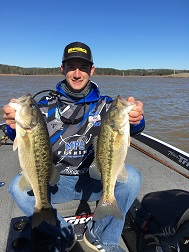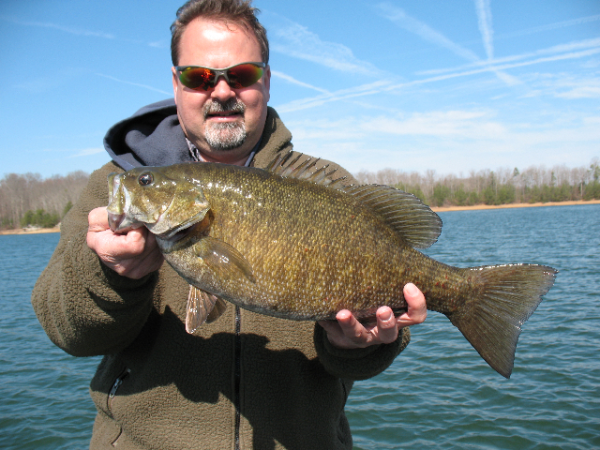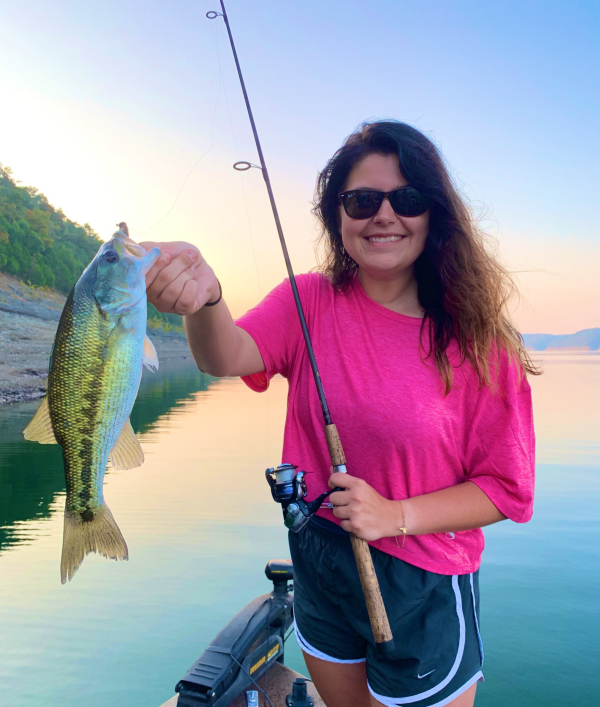September 2013 Lanier Bass
with Rob Jordan
Tired of summer doldrums fishing for bass in deep water and not catching much? There is light at the end of September, when water starts cooling and bass get more shallow and active on our lakes. But why wait several more weeks? You can catch some big spots at Lanier right now.
Lanier is a big lake at 40,000 acres and since it is just northeast of Atlanta it gets heavy pleasure boat traffic, especially on weekends. And it gets a lot of fishing pressure. The lake is known for its big spotted bass that took advantage of the introduction of blueback herring. Five pound spots are caught often and most tournaments are won on spotted bass, with five-fish limits weighing 15 pounds common.
Rob Jordan grew up fishing Lanier and now lives in Swanee. His cousin Jim Murray, Jr. got him started tournament fishing and taught him a lot about catching bass. Rob also worked with Jim painting custom lures and Rob has a business making realistic looking baits. He also guides on Lanier and fishes tournaments. Next year Rob plans on fishing the FLW Everstart and BASS Opens.
This year Rob fished the Savannah River BFL trail and is right on the qualifying point to fish the Regional at Lanier with one tournament to go. He hopes to do well in the Regional on his home lake.
Rob’s best five spots in a tournament on Lanier weighed 21.5 pounds. This summer he has had big fish in two night tournaments. Two years ago he placed third in the Weekend Series on Lanier and was in the top ten in the BFL there that year. He knows the lake and how to catch good spots.
“Lanier is a fantastic lake but you have to understand the waters and when the bass bite to do well,” Rob said. It is a unique lake and you won’t catch the big spots by fishing like you do on other lakes.
“The biggest spots are hard to catch since they roam the lake, living in water 50 to 60 feet deep,” Rob told me. Weather and moon phases are keys to figuring out the bite. And you have to fish in the right places to catch the quality spotted bass.
September is a transition month for spots on Lanier and you can catch some really big fish, especially late in the month. Last year Rob got a six pound, six ounce spot toward the end of September on a guide trip. But you can catch quality fish starting right now.
A wide variety of baits will catch spots on Lanier this month. Rob will have a drop shot worm and a shaky head worm ready for slower fishing. When the bite is good he likes a swim bait or a top water plug. All these baits are fished in deep water, with his boat often sitting in 80 plus feet of water and fishing water that is 30 feet deep.
Rob will try a variety of depths and lures until he finds where the bass are feeding, and that depth will usually be consistent all over the lower lake. The key is a long point or hump that drops off into very deep water. Standing timber in the deep water and brush or rocks on the humps and points make those places much better.
Rob took me to the following ten spots in early August and we caught fish on most of them. They are good right now and will get even better as the month progresses.
1. N 34 10.029 – W 84 02.492 – Green channel marker 3SC in Shoal Creek sits on a rocky hump right by the channel. There is also a danger marker on it and one small bush stuck out of the water when we were there. The hump is right off an island, too. It always holds bass, according to Rob, and it typical of the type place he fishes this month.
There is brush all over and around it as well as the natural rocks to hold feeding fish. Rob says it is important to locate the brush piles and fish them, so ride it with your electronics and mark the brush. Good electronics will even show the fish in the brush and how they are setting up on it.
Start on the upstream end and work the whole area, keeping your boat out in the channel. Wind rippling the surface of the water is critical here and on other spots to make the fish active, and overcast days help, too.
If there is some wind and some clouds try a big swim bait like the Bucca Bull Herring hard swim bait or a Zman Grass KickerZ over the brush. Topwater plugs like a big Spook or Sammy will draw the bass up to the top from the brush.
If the water is slick or it is sunny Rob will fish a Zman StreakZ on a drop shot or a Big Bass Baits jig head with a worm on it in the brush. It is important to get the baits right on the fish so work each brush pile carefully, especially if you see fish in or around it.
2. N 34 11.681 – W 83 03.607 – Run over to Young Deer Creek and right in the mouth of it on the left side going upstream marker 1YD sits on a hump with a danger marker and some bushes on top. Again, it is right on the channel where deep water is very close to shallow water.
Your boat should be in about 100 feet of water and you want to fish brush around 30 feet deep. Rob says 30 foot deep water is usually a good depth in September but they may feed a little shallower later in the month. If you are not catching fish in the deeper brush, or if you see them in more shallow brush, try it.
Rob says bass are caught here every day. There are a lot of brush piles and big rocks on the hump to cover. Try all your baits around them.
A big swim bait is Rob’s go-to bait if he wants quality fish. In a tournament where five bites from big fish is all you want, try the Bull Herring worked slowly over the brush. Rob’s custom painted versions are best since the spots on Lanier see so many swim baits but all will catch bass.
3. N 34 11.766 – W 84 03.499 – Across the mouth of Young Deer Creek channel marker 2YD sits on a deep rocky point that is excellent. Rob fishes the downstream end of the point where it runs out parallel to the channel. You will be sitting in 70 to 100 feet of water when fishing the end of the point.
First try the swimbaits and topwater. Always keep a topwater plug ready to cast immediately to surfacing fish. We caught a couple the day we fished when they came up near us. They may not stay up long so be ready. If the spots are consistently schooling on top but not staying long, Rob will stand in the front of the boat with a topwater bait ready to cast, waiting on them to come up again.
4. N 34 12.494 – W 84 01.432 – An island sits in the mouth of Six Mile Creek and marker 4SM sits just off it. The creek channel is on one side and the river channel on the other. Rob says this is one of the best big spot holes on the lake and he caught a six pounder here.
There are stumps and brush piles on the point on the downstream side of the island where the big spots live. Rob says a big swim bait or topwater is the way to go here for the big ones. Work both baits all around the point, concentrating on brush piles and stump beds you find with your electronics.
Rob fishes both hard and soft swimbaits with a steady retrieve and keeps them near the surface is there is cloud cover or wind on the water. When a fish hits he sets the hook with a sweep of his rod, not a hard set, and does not drop the rod tip.
If there is little wind or if the spots just don’t seem to eat the big bait, Rob will drop down to the smaller size Zman SwimmerZ soft swim bait. He fishes the soft baits on a three sixteenths to three quarter ounce jig head depending on how the fish set up. The lighter head is better for running the bait shallow but the bigger head will allow you to fish it a little faster and deeper.
5. N 34 13.464 – W 84 01.406 – Further up Six Mile Creek it narrows way down right at channel marker 7SM. There are several good humps and points in this area. The left side going upstream, between the last cove on that side to the point where the creek narrows way down, have the better ones.
The danger marker on the left sits between two long points that are excellent. Sit out in 45 feet of water and cast up into 25 to 30 feet of water. There are a couple of road beds, an old house foundation and brush piles on the points. Fish them all.
The pinch point where the creek narrows way down funnels fish into this area as they move up the creek in the fall. Rob says when the water temperature drops into the 70s it is like a switch turns on and the bass get into action chasing bait. Swim baits and topwater are even better when it cools down.
6. N 34 14.772 – W 83 56.843 – Run up the river to the mouth of Flat Creek. A big island sits in the mouth of it and red channel marker 26 is on a point where the river channel swings in toward it. Rob says bass live here year round and it is always good, but in September even more bass get on the point while moving into the creek.
Sit out in 40 feet of water and cast up on the point with all your baits, starting shallow and working deeper. There are rocks and brush piles here that hold the fish. If you can’t find the brush with your electronics, drag a jig head worm along the bottom until you hit rocks or brush and work it.
7. N 34 13.602 – W 83 55.772 – For a change of pace run into Mud Creek all the way to the narrow creek channel in the back. Rob fishes docks back in places like this. Spots and some big largemouth can be found back around docks in creeks as the water cools. Fish all the docks from the ones on the left past the big rocky point where it narrows down all the way around the creek.
Try a one eighth to three sixteenths ounce jig head with a Zman finesse worm on it. Fish all of each dock, from the deepest water in front of it to the back under the walkway. The bass may be feeding anywhere around the docks.
The bass will be on the outside deeper docks early in the month but move further back as the water cools. Since the weather this summer has been fairly cool and the rain and cool weather in the middle of August kept the water temperatures down, they may move further back sooner this year.
8. N 34 13.967 – W 83 56.271 – Going out of Mud Creek Old Federal day use park with a boat ramp is on your left. Past it a long point runs out toward the main lake and there is an island off the bank, with danger markers between it and the main point.
Stop about even with the island in Mud Creek and idle over the ridge that runs out on that side toward the Mud Creek channel. This ridge runs way out and has rock and brush on it, and bass stack up on it all summer long. Even more move to it as they follow shad back into the creek in the fall.
Sit in about 40 feet of water and cast up on top of the ridge to 20 to 30 feet of water. Try all your baits. When using a drop shot in the brush Rob likes to pitch it ahead of the boat a little rather than fishing it straight under the boat. He will let the lead hit bottom, raise his rod tip to keep the bait up off the bottom and twitch it in one place, moving the lead very slowly as he works it around the brush.
9. N 34 13.447 – W 83 57.774 – Out off the end of the point with Old Federal Campground there is a big flat point with a danger marker off a small island with bushes on top. There are brush piles all over it but Rob’s favorite area of this big point is downstream of the island and danger marker.
As in other places, start with topwater and swim baits over the brush piles you locate with your electronics, then try the dropshot and shaky head. Rob likes a light one sidxteenths to one eight head, as light as conditions will allow, since the slow fall will often draw a strike.
Rob lets the shaky head hit bottom then slowly drags it along with an occasional snap of the rod tip to make it wiggle and jump. Many people shake it in one place, as the name implies, but Rob moves it slowly along the bottom without constant shaking.
10. N 34 11.424 – W 83 58.442 – In Flowery Branch across from the Van Pugh ramp a long underwater point runs off the upstream side of the danger marker between the small island and the main point. This point actually runs off Van Pugh park out to the island then on out toward the creek channel.
Stay out on the creek end of the point and work it with all your baits. Resident fish live here and more move in during the fall. If you are fishing a tournament use big baits for a few quality bites. Use smaller topwater baits like the Sammy 100 early in the fall but go bigger later. For numbers the shaky head or drop shot will get more bites.
All these places hold bass right now and will get better as the month progresses and the water gets cooler. Give them a try and you can find many more just like them.
For a guide trip with Rod to see first hand how he fishes Lanier call him at 770-873-7135 and check his web site at http://robjordanfishing.com Also check out his custom painted baits at http://www.xtremelurecreations.com


